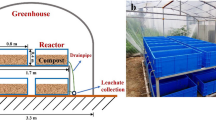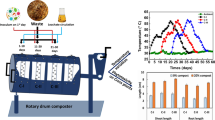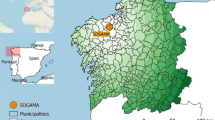Abstract
Due to changes in lifestyle and improved economic status, the use of diapers is also increasing in developing nations. Hence, there is a need to develop an eco-friendly system for the disposal of discarded diapers which is termed diaper waste (DW). In the present study, the co-composting of DW with household wet biodegradable waste (HWBW) was performed in a compartmentalized rotary drum (CRD) (total capacity = 160 L, number of compartments = 4) under passive aeration conditions. For the co-composting runs, 1 kg of HWBW and DW mixture (mass ratio = 100:0, 90:10, 85:15, and 80:20) was added in four individual compartments daily for 10 days. During the process, the highest temperature of ~ 50–56 °C could be achieved in different compartments for a duration of 2–8 days. The compost yield (i.e., below 4 mm size material) was ranged 10.4–13% after 55 days of composting and the mass of DW was reduced by ~ 61–68%. A mixture of 15% DW and 85% HWBW can be suggested as the best combination for the co-composting process. Based on the “Dewar test” results, the samples recovered after composting could be categorized as “stable”. The pot results showed an improvement in the growth of Vigna Radiata when 10% compost sample was mixed with soil whereas with 20% compost in the soil-compost mixture, the plant growth was adversely affected. Hence, co-composting of DW with HWBW can be a feasible proposition which can produce a good quality compost.






Similar content being viewed by others
Data availability
All data generated or analysed during this study are included in this published article and its supplementary information files.
References
Adani F, Genevini PL, Gasperi F, Tambone F (1999) Composting and humification. Compost Sci Util 7(1):24-33https://doi.org/10.1080/1065657X.1999.10701949
APHA (2012) Standard methods for the examination of water and wastewater, 22nd edition. American Water Works Association and Water Environment Federation, Washington DC, USA.
ASTM (2019) Standard test method for volatile matter in the analysis of particulate wood fuels, West Conshohocken, USA
ASTM (2021) Standard test method for ash in wood, West Conshohocken, USA
Arena U, Ardolino F, Gregorio FD (2016) Technological, environmental and social aspects of a recycling process of post-consumer absorbent hygiene products. J Clean Prod 127:289–301. https://doi.org/10.1016/j.jclepro.2016.03.164
Asik BB, Turan MA, Celik H, Katkat AV (2009) Effects of humic substances on plant growth and mineral nutrients uptake of wheat (Triticum durum cv. Salihli) under conditions of salinity. Asian J Crop Sci 1(2):87–95. https://doi.org/10.3923/ajcs.2009.87.95
Awasthi MK, Pandey AK, Khan J, Bundela PS, Wong JWC, Selvam A (2014) Evaluation of thermophilic fungal consortium for organic municipal solid waste composting. Bioresour Technol 168:214–221. https://doi.org/10.1016/j.biortech.2014.01.048
Ayilara MS, Olanrewaju OS, Babalola OO, Odeyemi O (2020) Waste management through composting: challenges and potentials. Sustain 12(11):4456. https://doi.org/10.3390/su12114456
Bary AI, Cogger CG, Sullivan DM, Myhre EA (2005) Characterization of fresh yard trimmings for agriculture use. Bioresour Technol 96(13):1499–1504. https://doi.org/10.1016/j.biortech.2004.11.011
Bohacz J (2017) Lignocellulose-degrading enzymes, free-radical transformations during composting of lignocellulosic waste and biothermal phases in small-scale reactors. Sci Total Environ 580:744–754. https://doi.org/10.1016/j.scitotenv.2016.12.021
Brinton WF, Evans E, Droffner ML, Brinton RB (1995) A standardized Dewar test for evaluation of compost self-heating. Biocycle 36(11):1–16
Chen W, Westerhoff P, Leenheer JA, Booksh K (2003) Fluorescence excitation-emission matrix regional integration to quantify spectra for dissolved organic matter. Environ Sci Technol 37(24):5701–5710. https://doi.org/10.1021/es034354c
Chen X, Du G, Wu C, Li Q, Zhou P, Shi J, Zhao Z (2022) Effect of thermophilic microbial agents on nitrogen transformation, nitrogen functional genes, and bacterial communities during bean dregs composting. Environ Sci Pollut Res 29:31846–31860. https://doi.org/10.1007/s11356-021-17946-w
Colón J, Ruggieri L, Sánchez A, González A, Puig I (2011) Possibilities of composting disposable diapers with municipal solid wastes. Waste Manag Res 29(3):249–259. https://doi.org/10.1177/0734242x10364684
Colón J, Mestre-Montserrat M, Puig-Ventosa I, Sánchez A (2013) Performance of compostable baby used diapers in the composting process with the organic fraction of municipal solid waste. Waste Manag 33(5):1097–1103. https://doi.org/10.1016/j.wasman.2013.01.018
Crohn DM (2016) Assessing compost quality for agriculture. Agriculture and Natural Publication. https://escholarship.org/uc/item/4v1576f8. Accessed 25 January 2023
Dey S, Purdon M, Kirsch T, Helbich H, Kerr K, Li L, Zhou S (2016) Exposure factor considerations for safety evaluation of modern disposable diapers. Regul Toxicol Pharmacol 81:183–193. https://doi.org/10.1016/j.yrtph.2016.08.017
El-Mrini S, Aboutayeb R, Zouhri A (2022) Effect of initial C/N ratio and turning frequency on quality of final compost of turkey manure and olive pomace. J Eng Appl Sci 69:37. https://doi.org/10.1186/s44147-022-00092-6
Ermolaev E, Sundberg C, Pell M, Jönsson H (2014) Greenhouse gas emissions from home composting in practice. Bioresour Technol 151:174–182. https://doi.org/10.1016/j.biortech.2013.10.049
Espinosa-Valdemar RM, Sotelo-Navarro PX, Quecholac-Piña X, García-Rivera MA, Beltrán-Villavicencio M, Ojeda-Benítez S, Vázquez-Morillas A (2014) Biological recycling of used baby diapers in a small-scale composting system. Resour Conserv Recycl 87:153–157. https://doi.org/10.1016/j.resconrec.2014.03.015
Fan YV, Lee CT, Klemeš JJ, Chua LS, Sarmidi MR, Leow CW (2018) Evaluation of effective microorganisms on home scale organic waste composting. J Environ Manag 216:41–48. https://doi.org/10.1016/j.jenvman.2017.04.019
Garg A, Tothill IE (2009) A review of solid waste composting process - the UK perspective. Dyn Soil Dyn Plant 3 (Special issue 1):57–63
Hernández-Gómez A, Calderón A, Medina C, Sanchez-Torres V, Oviedo-Ocaña ER (2021) Implementation of strategies to optimize the co-composting of green waste and food waste in developing countries. A case study: Colombia. Environ Sci Pollut Res 28:24321–24327. https://doi.org/10.1007/s11356-020-08103-w
Heyman H, Bassuk N, Bonhotal J, Walter T (2019) Compost quality recommendations for remediating urban soils. Int J Environ Res Public Health 16(17):3191. https://doi.org/10.3390/ijerph16173191
Hwang SCJ, Wu BR, Tsai M, Tkáč Š (2017) Sustainable used diaper recycler. https://www.researchgate.net/publication/327201903_Sustainable_used_diaper_recycle. Accessed on 27 January 2022
Kalamdhad AS, Kazmi AA (2009) Rotary drum composting of different organic waste mixtures. Waste Manage Res 27(2):129–137. https://doi.org/10.1177/0734242X08091865
Keoleian GA, Bulkley JW, DeYoung R, Duncan A, McLaughlin E, Menerey D, Monroe M, Swenson T (1991) Waste reduction in children’s day care: case study report of Gretchen’s. Center for Sustainable Systems Publication. https://css.umich.edu/publication/waste-reduction-childrens-day-care-case-study-report-gretchens. Accessed on 25 January 2023
Khoo SC, Phang XY, Ng CM, Lim KL, Lam SS, Ma NL (2019) Recent technologies for treatment and recycling of used disposable baby diapers. Process Saf Environ Prot 123:116–129. https://doi.org/10.1016/j.psep.2018.12.016
Manu MK, Kumar R, Garg A (2017) Performance assessment of improved composting system for food waste with varying aeration and use of microbial inoculum. Bioresour Technol 234:167–177. https://doi.org/10.1016/j.biortech.2017.03.023
Manu MK, Kumar R, Garg A (2019) Decentralized composting of household wet biodegradable waste in plastic drums: effect of waste turning, microbial inoculum and bulking agent on product quality. J Clean Prod 226:233–241. https://doi.org/10.1016/j.jclepro.2019.03.350
Manu MK, Kumar R, Garg A (2021) Effect of microbial inoculum and leachate circulation on the performance of rotary drum composter used for household wet biodegradable waste. Waste Biomass Valor 12:6119–6137. https://doi.org/10.1007/s12649-021-01430-0
Manyapu V, Mandpe A, Kumar S (2018) Synergistic effect of fly ash in in-vessel composting of biomass and kitchen waste. Bioresour Technol 251:114–120. https://doi.org/10.1016/j.biortech.2017.12.039
Meng X, Chen WW, Wang YY, Huang ZR, Ye X, Chen LS, Yang LT (2021) Effects of phosphorous deficiency on the absorption of mineral nutrients, photosynthetic system performance and antioxidant metabolism in Citrus grandis. PLoS ONE 16(2): e0246944. https://doi.org/10.1371/2Fjournal.pone.0246944
MOEFCC (2016a) Solid waste management rules, Government of India, New Delhi.
MOEFCC (2016b) Selection criteria for waste processing technologies, Government of India, New Delhi.
MoUD (2016) Municipal solid waste management manual, Government of India, New Delhi.
Nadia OF, Xiang LY, Lie LY, Anuar DC, Afandi MPM, Baharuddin SA (2015) Investigation of physico-chemical properties and microbial community during poultry manure co-composting process. J Environ Sci 28:81–94. https://doi.org/10.1016/j.jes.2014.07.023
Nikbakht A, Kafi M, Babalar M, Xia YP, Luo A, Etemadi N (2008) Effect of humic acid on plant growth, nutrient uptake, and postharvest life of Gerbera. J Plant Nutr 31(12):2155–2167. https://doi.org/10.1080/01904160802462819
Oishi W, Sano D, Decrey L, Kadoya S, Kohn T, Funamizu N (2017) Identification of the inactivating factors and mechanisms exerted on MS2 coliphage in concentrated synthetic urine. Sci Total Environ 598:213–219. https://doi.org/10.1016/j.scitotenv.2017.04.088
Oviedo-Ocaǹa ER, Dominguez I, Komilis D, Sánchez A (2019) Co-composting of green waste mixed with unprocessed and processed food waste: influence on the composting process and product quality. Waste Biomass Valor 10:63–74. https://doi.org/10.1007/s12649-017-0047-2
Pampuro N, Bisaglia C, Romano E, Brambilla M, Pedretti EF, Cavallo E (2017) Phytotoxicity and chemical characterization of compost derived from pig slurry solid fraction for organic pellet production. Agric 7(11):94. https://doi.org/10.3390/agriculture7110094
Shareef RS, Mamat AS, Al-Shaheen MR (2019) The effect of soil pH, high calcium compost and cadmium on some of growth characters in corn (Zea maysl). ARC J Pharm Sci 5(4):16–27. https://doi.org/10.20431/2455-1538.0504003
Smidt E, Meissl K (2007) The applicability of Fourier transform infrared (FT-IR) spectroscopy in waste management. Waste Manag 27(2):268–276. https://doi.org/10.1016/j.wasman.2006.01.016
Sullivan DM, Bary AI, Miller RO, Brewer LJ (2018) Interpreting compost analyses. Oregon State University Extension Service. https://catalog.extension.oregonstate.edu/sites/catalog/files/project/pdf/em9217.pdf. Accessed on 25 January 2023
Takaya CA, Cooper I, Berg M, Carpenter J, Muir R, Brittle S, Sarker DK (2019) Offensive waste valorisation in the UK: assessment of the potentials for absorbent hygiene product (AHP) recycling. Waste Manag 88:56–70. https://doi.org/10.1016/j.wasman.2019.03.022
Tchobanoglous G, Theisen H, Vigil SA (2014) Integrated solid waste management: engineering principles and management issues. McGraw Hill Education Private Limited, India
Varma VS, Das S, Sastri CV, Kalamdhad AS (2017) Microbial degradation of lignocellulosic fractions during drum composting of mixed organic waste. Sustain Environ Res 27(6):265–272. https://doi.org/10.1016/j.serj.2017.05.004
Wambui KE, Joseph M, Makindi S (2015) Soiled diapers disposal practices among caregivers in poor and middle income urban settings. Int J Sci Res Publ 5(10):1–10
Willis RB, Montgomery ME, Allen PR (1996) Improved method for manual, colorimetric determination of total kjeldahl nitrogen using salicylate. J Agric Food Chem 44(7):1804–1807
Wu DL, Liu P, Luo YZ, Tian GM, Mahmood Q (2010) Nitrogen transformations during co-composting of herbal residues, spent mushrooms, and sludge. J Zhejiang Univ Sci B 11(7):497–505. https://doi.org/10.1631/jzus.B0900271
Xu K, Wang C, Liu H, Qian Y (2011) Simultaneous removal of phosphorus and potassium from synthetic urine through the precipitation of magnesium potassium phosphate hexahydrate. Chemosphere 84(2):207–212. https://doi.org/10.1016/j.chemosphere.2011.04.057
Yeh CK, Lin C, Shen HC, Cheruiyot NK, Camarillo ME, Wang CL (2020) Optimizing food waste composting parameters and evaluating heat generation. Appl Sci 10(7):2284. https://doi.org/10.3390/app10072284
Zabel RA, Morrell JJ (2020) Chemical changes in wood caused by decay fungi. In: Wood Microbiology: Decay and its prevention, 2nd edition. Academic Press, USA, pp 215-244
Zhang D, Luo W, Li Y, Wang G, Li G (2018) Performance of co-composting sewage sludge and organic fraction of municipal solid waste at different proportions. Bioresour Technol 250:853–859. https://doi.org/10.1016/j.biortech.2017.08.136
Zhao C, Jiang E, Chen A (2017) Volatile production from pyrolysis of cellulose, hemicellulose and lignin. J Energy Inst 90(6):902–913. https://doi.org/10.1016/j.joei.2016.08.004
Zhou Y, Selvam A, Wong JWC (2014) Evaluation of humic substances during co-composting of food waste, sawdust and Chinese medicinal herbal residues. Bioresour Technol 168:229–234. https://doi.org/10.1016/j.biortech.2014.05.070
Acknowledgements
The author wishes to thank the workers who helped in the collection of waste for the experimental study. The authors would also like to thank the Sophisticated Analytical Instrument Facility and central facility of Chemistry Department, IIT Bombay, for conducting the analysis of solid samples. The first author is grateful to the Ministry of Human Resources and Development, New Delhi, India, for providing him the fellowship to carry out the research work for his doctoral degree.
Author information
Authors and Affiliations
Contributions
Both the authors contributed to the study conception and design. Investigation and formal analysis were performed by Barun Kanoo. Interpretation of the results was performed by both the authors. The first author also prepared the first draft. Anurag Garg commented and edited the manuscript versions. Both authors read and approved the final manuscript.
Corresponding author
Ethics declarations
Ethics approval and consent to participate
Not applicable.
Consent for publication
Not applicable.
Competing interests
The authors declare no competing interests.
Additional information
Responsible Editor: Ta Yeong Wu
Publisher's note
Springer Nature remains neutral with regard to jurisdictional claims in published maps and institutional affiliations.
Supplementary Information
Below is the link to the electronic supplementary material.
Rights and permissions
Springer Nature or its licensor (e.g. a society or other partner) holds exclusive rights to this article under a publishing agreement with the author(s) or other rightsholder(s); author self-archiving of the accepted manuscript version of this article is solely governed by the terms of such publishing agreement and applicable law.
About this article
Cite this article
Kanoo, B., Garg, A. Effect of diaper waste on composting of household wet biodegradable waste in a decentralized system. Environ Sci Pollut Res 30, 98966–98976 (2023). https://doi.org/10.1007/s11356-023-25942-5
Received:
Accepted:
Published:
Issue Date:
DOI: https://doi.org/10.1007/s11356-023-25942-5




